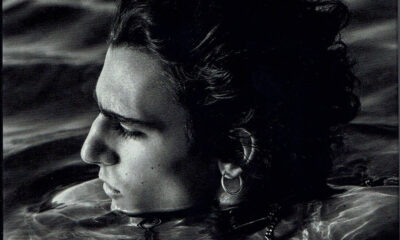Music
Album Review: Big K.R.I.T – ‘K.R.I.T. Iz Here’
A survivor returns with a statement of rebirth.
It’s been nine years since Big K.R.I.T. dropped his breakthrough mixtape K.R.I.T. Wuz Here, which launched him into a new class of upcoming rappers who would kick off the new wave of 2010s rap.
The critical acclaim landed him a spot in XXL’s 2011 Freshman class and put him in conversations with names like Kendrick Lamar, J. Cole, Mac Miller, and Meek Mill. But, it’s safe to say the Mississippi rapper has not garnered the same hype or mainstream success as some of his contemporaries since then.
This fact may be what continues to propel his artistry or, at the very least, explain the aggression in multiple verses. Despite not measuring up in accolades, radio plays, and sales, K.R.I.T. has proved he can go the distance as an underground artist. With his new project, K.R.I.T. reemerges as a seasoned rapper, comfortably accepting his path on the road less traveled. The album sounds like the rebirth of an artist no longer chained to industry demands.
K.R.I.T. Iz Here is the official sequel to his 2010 tape. It paints the picture of a self-proclaimed titan — the same one who unleashed his frustrations with the entire industry on the 2014 track, “Mount Olympus”, which was released as a response to Kendrick Lamar’s infamous “Control” verse, yelling from the mountain top after a ten year climb. Add to the mix a mainstream trap avalanche that has let K.R.I.T.’s experimental southern sound fall on deaf ears and his former record label, Def Jam, attempting to steer his artistry in that exact direction. K.R.I.T. officially parted ways with Def Jam in 2016.
K.R.I.T. sounds more relaxed and playful with his flow and voice, a clear indication that the rapper has more breathing room and less constrictions on his creativity. He also makes sure to stay true to this roots on this album. Not that he ever strayed too far from his Mississippi mix of R&B, blues, and soul. The album features samples from The Winans, Jill Scott, and Cherrelle. It also features a fair balance of up-tempo, flashy tracks as well as slower, more reflective ones.
The album opens with “K.R.I.T. Here” which samples “Trust in God” by The Winans. “K.R.I.T. here, sound like this is my year” is the first line of his first verse. It says he never went anywhere and hasn’t lost his drive. There are tracks such as “Believe” that focus on blind faith and hold enough hope to counter the vices like codeine abuse and women. These same vices make up the theme of “Addiction” featuring Lil Wayne and Saweetie. “Addiction” was released as the second single from the album.
Then there are cuts like “I Been Waitin”, where K.R.I.T. reminds listeners that he has paid nothing short of his dues and “I Made” featuring Yella Beezy, where he glides over a speedy beat demanding props for “making something out of nothing.” K.R.I.T. also makes room on his album to pay homage to some of his biggest influences. “Learned from Texas” salutes rap duo UGK and DJ Screw.
The standout track is the last one on the record, dedicated to his home state. “M.I.S.S.I.S.S.I.P.P.I” incorporates strums of the upright bass, piano riffs, and horns, while clanking glasses and crowd chatter can be heard in the background. K.R.I.T. treats the track like a spoken word piece with his laid back, conversational rhyming. The music and lyrics both feel improvisational and create an ambiance of a southern speakeasy.
There are other notable tracks on the album such as “Blue Flame Ballet, which serves as a funky ode to strip clubs and exotic dancers. The beat sounds fresh out of the 70’s. K.R.I.T.’s approach to this track showcases his range. There are many hip hop tracks that choose the strip club as its central theme. But, the beats and tempo usually mirror the energy of that setting– fast, loud, and erratic. K.R.I.T. visualizes this scene differently on this track. “This is art”, he says, as he paints the image of a slow, graceful, ballet rather than a lap dance.
There’s also “Prove It” which features a verse from J. Cole. Despite featuring another major rap artist, the track does not feel necessary for the project. The production dulls in comparison to the lyricism of K.R.I.T. and Cole combined. The beat is somewhat too mellow to match the hype both rappers are able to acquire. The auto-tuned singing during the hook waters down the potency of the verses. It feels awkwardly stuck in between being another song for radio play and being one that showcases the ability of two underground rappers.
Two interludes are on the album. One includes a silly conversation between Mississippi comedian Karlous Miller and Wild-N-Out star, Chico Bean. The other is a skit from Atlanta DJ Swamp Izzo. Though the interludes maintain the southern essence that defines K.R.I.T.’s artistry, their humorous nature don’t feel a part of the rest of the album.
Despite certain elements not feeling cohesive, K.R.I.T.’s message maintains itself throughout the project. He is here for the long haul and takes pride in his unwillingness to convert to a mainstream rapper. K.R.I.T. realizes he is solidified as a ten year veteran and this is the project that marks his arrival as a reborn artist.
If you obsess over singers and bands, and are one of those people who make a playlist for every occasion, join CMN’s Music Journalism Course and get real-time experience, intense feedback on your writing, exposure to music industry insiders, and a great place to display build your portfolio. Get all the details on the Music Journalism Course here.











